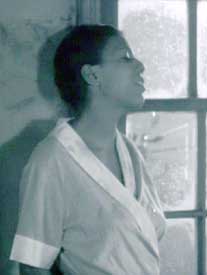 Edward "Duke" Ellington with his bandmembers always dressed so simply & elegantly, never falling victims to the hipness of passing fashion & going for the classic.
Edward "Duke" Ellington with his bandmembers always dressed so simply & elegantly, never falling victims to the hipness of passing fashion & going for the classic.
For the one-reel Bundle of Blues (1933) they have a stage setting that is as streamlined & tasteful as as their physical baring. Ellington's was the orchestra that represented the height of good taste in image as well as sound.
As the film begins we're hearing "Lightnin" which blends right into "Rockin' in Rhythm" which includes a Joe Nanton trumbone solo, followed in quick order by an instrumentalizing "Stormy Weather" which Duke calls "a haunting melody." It's a great song performed by great musicians.
Then, stepping out from a curtain, Ivie Anderson appears, to provide the purist of pure interpretation to the lyrics.
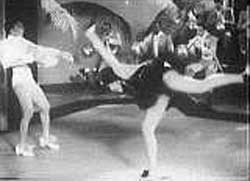 Most of us know Lena's version best & think of it as her song, but Ivie Anderson was one of the greatest blues singers of her generation. Most of us know Lena's version best & think of it as her song, but Ivie Anderson was one of the greatest blues singers of her generation.
The set & Ivie's lovely gown fade away into a poor woman's raiment & home. Sad Ivie gazes out the window into the storm.
The rural landscape will also illustrate Joe Nanton's second trumbone solo, effectively poetic.
Moods shift rapidly in these miniature musical films, & A Bundle of Blues leaps from the sorrows of Ivie on "Stormy Weather" to the jazzy "Bugle Call Rag," with Florence Hill & Bessey Dudley tapdancing with angular abandon.
This is a lovely little film, but it's only a warm-up for Duke Ellington's best film, with the same director, illustrating one of his most important compositions:
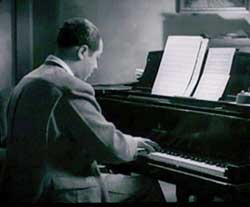 Symphony in Black: A Rhapsody of Negro Life (1935) begins with the premise that Duke Ellington has two weeks to complete his "Negro Moods" which are slated to debut at the end of that time.
Symphony in Black: A Rhapsody of Negro Life (1935) begins with the premise that Duke Ellington has two weeks to complete his "Negro Moods" which are slated to debut at the end of that time.
We see him in his small private studio hard at work at his piano, struggling with the final touches for the titular symphony in four main parts.
The scene of him alone working forms part of the first movement "Laborers," a slow powerful march rhythm inspired by fieldhand work songs.
The scene fades to a club stage with his orchestra two weeks later, & fades again to gloomy film noir images of muscular stevedors shovelling coal, & laborers carrying heavy loads. And that visual match of music to labor tells a bigger story of struggle than just the work.
The second movement's overall title is "A Triangle" in three sections, "Dance," "Jealousy," & "Blues," with featured solos from Barney Bigard on clarinet for "Blues," & from trumbonist Joe Nanton for both "Dance" & "Blues."
It begins with a jumping dance beat then cuts to a man & woman doing the Lindy Hop in an apartment. Another woman is in the street below watching the couple's shadows on the window curtains.
The movement slides from "Dance" to "Jealousy." When the couple comes down to the street, heading off to a jazz club after practicing their dance moves, the jealous woman grabs the man, but he pushes her roughly to the ground.
The last third of the second part, "Blues," lingers on that jealous woman cast to the ground, who is none other than Billie Holiday, who begins singing, "When My Man Walked Out on Me."
This splendid moment in the one-reel Symphony in Black was Billie's oh-so-memorable film debut at age eighteen, already world-weary.
The third movement is "A Hymn to Sorrow," a moody pretty low theme, cutting to sad faces in a dark church, a ghostly funeral rite. This impressionistic scene of sorrow slowly fades & Part Four "Harlem Rhythm" lifts the spirits back up.
The camera again jump-cuts from Duke composing at home to his band on the stage to the Harlem nightlife scenes of jazz dancers. Shadowy anonymous babes are dancing together with Earl "Snakehips" Tucker who is performing his "eccentric dance" as the film ends with surrealist imagery.
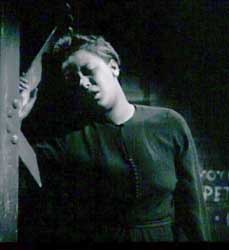 Some have suggested the unidentified dance couple earlier in the film, doing the Lindy, were Snakehips &s his recurring performing partner Bessie Dudley.
Some have suggested the unidentified dance couple earlier in the film, doing the Lindy, were Snakehips &s his recurring performing partner Bessie Dudley.
But Steve Laskers has pointed out that Billie herself, complaining in her book Lady Sings the Blues about how rough the guy was in take after take shoving her to the ground, says the guy was a commedian whose name she could not remember, which wouldn't've been Snakehips.
The boyfriend/pimp who knocks Billie down has alternatively been idetnfied as Scatman Crothers, but without sound basis. The woman dancer, however, might indeed by Bessie Dudley who definitely appears in Bundle of blues. But Lasker has provided clues that she was actuall Florence Edmondson.
In any case, Snakehips Tucker had been a regular Harlem performer at Connie's, the Savoy, & the Cotton Club. He was known as the "the human boa constrictor" because of the amazing twists of his dance creation.
He'd been inspired to his dance creation, in the 1920s, by the shimmering chemise gown of Gilda Grey the popular "shimmy dancer." But Snakehips' was also building on "the Congo dance" that had long been performed by Congolese Americans in Congo Square, New Orleans. Ellington put him in Symphony in Black only two years before his untimely death, supposedly of intestinal disease.
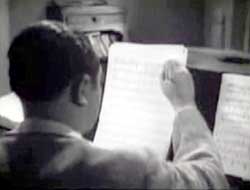 Symphony in Black may well be the best jazz film of the 1930s, if not ever, mixing the best music imaginable with incredible cinematic imagery. Many such films were hamstrung by lack of budgets if not lack of imagination, but this is visually & in every regard a flawless gem. Symphony in Black may well be the best jazz film of the 1930s, if not ever, mixing the best music imaginable with incredible cinematic imagery. Many such films were hamstrung by lack of budgets if not lack of imagination, but this is visually & in every regard a flawless gem.
Ellington was the embodiment of good taste. A lot of the jazz films of the 1930s -- & there were many -- feature images of African Americans that have to be forgiven in order to appreciate the music. And in Ellington's "jungle music" period & with images to illustrate the blues or religious devotion or a night out on the town, it would have been all too easy to fall into the familiar stereotypes of other films.
So it's no accident that Duke Ellington & His Orchestra not only dressed to the nines, but involved themselves in filmic imagery that everyone could take pride in.
You'll never convince me Louis Armstrong permitted himself to be dressed up like a jungle cannibal because he thought it was cool, but more because success meant not making too many waves & demands. Duke must've been in his own way a powerful politician to fend off even the well-meant but misguided.
Ellington's consciousness & his subtle but powerful contribution to the civil rights movement is nicely documented in the PBS production American Experience: Duke Ellington (1992) which includes interviews, home movie footage, & performance footage, with an eye to showing how Duke represented & promoted African American cultural heritage at its best.
copyright © by Paghat the Ratgirl
|
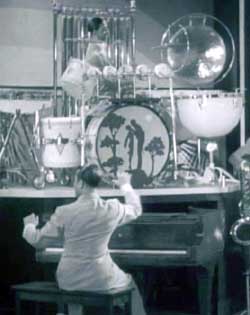

 Most of us know Lena's version best & think of it as her song, but Ivie Anderson was one of the greatest blues singers of her generation.
Most of us know Lena's version best & think of it as her song, but Ivie Anderson was one of the greatest blues singers of her generation.

